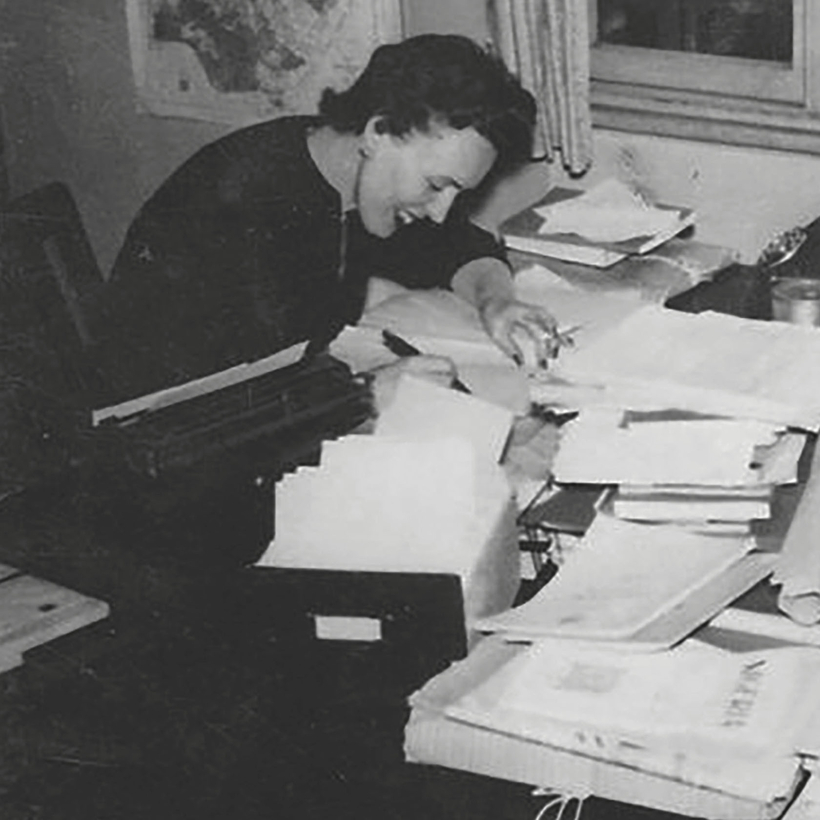“The agony of wondering if he will send a Christmas card!” The 20th-century British novelist Barbara Pym confided this pain to her diary, but it reflects the essence of so much of her fiction and her life: a genteel spinster besotted with an unattainable (i.e., indifferent, married, or gay) man, living in the excruciating hope of a scrap of kindness, acknowledgment.
And yet, the reader smiles, too. In the eight novels published during her life, Pym knitted gentle social comedies set in the world of church halls, dreary bedsits, and prim studies of archdeacons and anthropologists, where middle-class women find their life’s work smoothing the paths of men they silently adore, tidying up after them, hoping for a kind word.
Paula Byrne’s new doorstop of a biography, at more than 700 pages, might seem over the top for this modest author, but The Adventures of Miss Barbara Pym is a most entertaining account of Pym’s many lives—her inner life, her creative life, and her real life, woven as neatly as the socks both she and her characters are constantly darning for unappreciative men.
Recalling the picaresque novels of the 18th century, narrative titles open every chapter of the book; for instance, “In which Miss Barbara Pym goes up to St. Hilda’s College, Oxford.” This could have been a tiresome device, but most chapters are only a few pages long, and the often intriguing titles—“In which Fräulein Pym falls for a Handsome Nazi,” “In which Mr. Philip Larkin is Disgruntled (when is he not?)”—pull the reader along on the tide of a surprising and well-documented life.
Lessons in Love
Born in 1913, Pym grew up in Shropshire, near Wales, and at 18 left home to attend Oxford. There, she began to reveal lasting traits. She fell in love easily, sometimes at a mere glance in the Bodleian Library, and pursued her targets rigorously, becoming an expert stalker. She invented different personae for herself, sometimes complete with different names, clothes, and makeup.

But Pym’s love life was not entirely imaginary. She had full-blown affairs with several young men, a bold step in the Oxford of the 1930s. She also began writing novels, starting with the manuscript of Some Tame Gazelle, which, 15 years later, would become her first published work.
From her undergraduate days on, Pym was rarely without a novel in the works. After the well-received publication of Some Tame Gazelle, in 1950, she produced five more in 11 years, all rich with her close observations of lives of duty and disappointment, turned comic in her unerring hands.
When, to Pym’s dismay, her seventh novel was coldly rejected, in 1963, she found herself in a publishing wilderness that lasted 15 years. She continued to write, but after she had been turned down by 21 publishers, she resigned herself to a fatal fall out of fashion.
Narrative titles open every chapter of the book: “In which Fräulein Pym falls for a Handsome Nazi,” for instance, or “In which Mr. Philip Larkin is Disgruntled (when is he not?).”
In 1977, however, she was swept in from the cold by a survey in The Times Literary Supplement of the most underrated authors of the century. Only Pym was named twice, by her friend the poet Philip Larkin and by the eminent Oxford professor Lord David Cecil. The next day her recognition was front-page news, igniting a Pym renaissance with offers from publishers, reprints of her old novels, and interviews on radio and television, in newspapers and magazines. Her rejected manuscripts were published at once to critical acclaim.
This unexpected resurrection was in fact a glorious curtain call. In 1979, Pym was diagnosed with breast cancer. She died the following year. Four more of her novels were published posthumously, making a round dozen well worth reading—as is this excellent biography.
Robin Olson is a Los Angeles–based writer and editor

